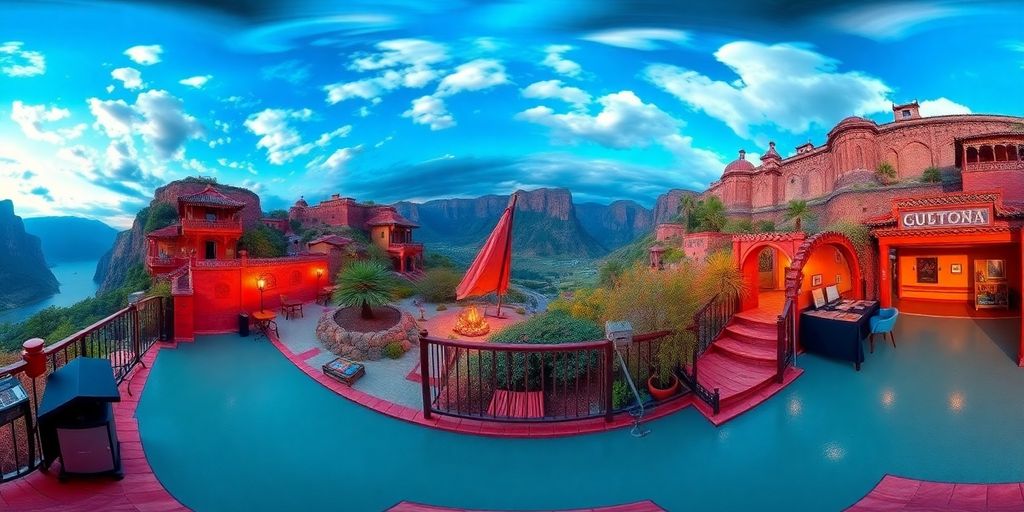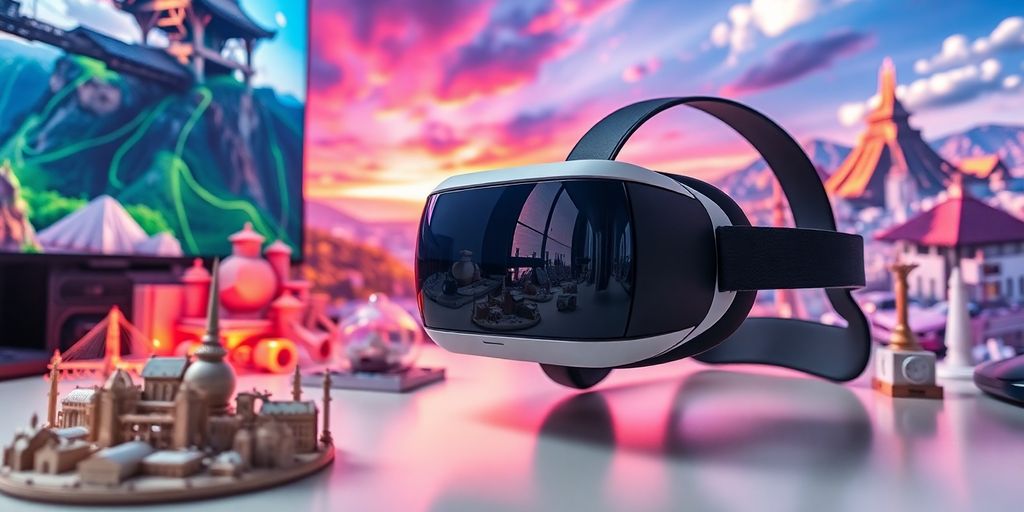In today’s digital world, 360 virtual tour software is changing the game for businesses and creators. This guide will help you understand how to create immersive virtual tours that grab attention and engage users. Whether you're in real estate, education, or tourism, these tools can help showcase spaces like never before. Let’s dive into the essentials of 360 virtual tour software and see how you can use it to craft compelling experiences.
Key Takeaways
- 360 virtual tour software allows users to create engaging and interactive virtual experiences.
- High-quality content and good planning are crucial for effective virtual tours.
- Integrating multimedia elements can significantly enhance user engagement.
- Choosing the right platform for publishing your tour is essential for reaching a wider audience.
- Staying updated on future trends in 360 virtual tour software can keep your content fresh and relevant.
Understanding 360 Virtual Tour Software
Defining 360 Virtual Tour Software
Okay, so what is 360 virtual tour software, really? It's basically the tech that lets you build and explore those cool, immersive virtual environments. Think of it as a way to stitch together panoramic images and add interactive stuff so people can explore a place without actually being there. It uses algorithms to blend images from 360-degree cameras into a seamless view. It's like giving people a digital key to explore spaces from every angle.
Key Features of 360 Virtual Tour Software
So, what makes this software tick? Here are some things that are usually included:
- Image Stitching: This is where the software takes multiple photos and blends them together to create that full 360-degree view.
- Interactive Elements: Hotspots, info points, videos, you name it. These make the tour more than just a visual experience.
- Navigation Tools: Easy ways for users to move around the tour, zoom in, and check things out from different perspectives.
It's important to remember that while virtual tours are awesome, they aren't perfect. Creating really good ones can take some know-how and the files can be pretty big, which might slow things down. Finding the right balance between quality and file size is key.
The Importance of Immersive Experiences
Why bother with all this? Well, immersive experiences are kind of a big deal these days. They can really grab someone's attention and make them feel like they're actually there. Think about it:
- Engagement: People are more likely to stick around and explore if they feel like they're part of the experience.
- Information Retention: Immersive experiences can help people remember things better.
- Accessibility: Virtual tours can let people explore places they might not be able to visit in person.
Plus, with everything that's been going on in the world, virtual tours have become even more important. They offer a way to explore and discover without having to travel. It's about making experiences more inclusive and accessible to everyone.
Creating Engaging Virtual Tours
Planning Your Virtual Tour
Okay, so you want to make a virtual tour that doesn't bore people to tears? First, you gotta plan. Think about the story you want to tell. What are the key spots people need to see? What's the flow? Don't just throw a bunch of 360 images together and call it a day. That's a recipe for a snooze-fest.
- Define the purpose of your tour. Is it for selling houses, showing off a museum, or something else?
- Map out the locations and the order in which people will visit them.
- Identify key features or points of interest at each location.
Think of it like directing a movie. You wouldn't just film random scenes, would you? You'd have a script, a storyboard, a plan. Same goes for virtual tours. A little prep goes a long way.
Capturing High-Quality 360-Degree Content
Alright, time to get technical. You can't make a great tour with crummy images. Invest in a decent 360 camera. Your phone probably won't cut it, unless you're going for that
Integrating Interactivity in Virtual Tours
Adding Interactive Elements
Okay, so you've got your 360 tour, but it's just... sitting there. Time to spice things up! Adding interactive elements is what really makes a virtual tour pop. Think about it: clickable hotspots that reveal extra info, embedded videos that play when you look at a certain spot, or even little quizzes to test people's knowledge of the space. It's all about making the experience more engaging than just a passive viewing.
Here's a few ideas:
- Information Hotspots: Clickable icons that reveal text, images, or videos.
- Embedded Media: Integrate videos, audio clips, or even other virtual tours within the main tour.
- Interactive Quizzes: Test the user's knowledge about the location or subject matter.
Configuring User Navigation
Navigation is key. You don't want people getting lost or frustrated trying to figure out how to move around. Make it intuitive! Think clear pathways, easy-to-understand controls, and maybe even a map to show where they are in the space. A good virtual tour should feel like a natural extension of real-world movement.
Here's what to keep in mind:
- Intuitive Controls: Use standard navigation symbols and controls that users are familiar with.
- Clear Pathways: Guide users through the space with visual cues and clear transitions.
- Map Integration: Provide a map or floor plan to help users orient themselves within the tour.
Think about how you naturally move through a space in real life. Try to replicate that feeling in your virtual tour. The less people have to think about how to navigate, the more they can focus on the content.
Utilizing Multimedia for Engagement
Don't just rely on visuals! Multimedia is your friend. Audio narration can add context and depth, while background music can set the mood. Videos can showcase specific features or provide additional information. The key is to balance it all so it doesn't become overwhelming. You want to enhance the experience, not distract from it. Think about adding some interactive elements to keep the user engaged.
Consider these multimedia options:
- Audio Narration: Provide commentary and information about the space.
- Background Music: Set the mood and create a more immersive atmosphere.
- Embedded Videos: Showcase specific features or provide additional context.
Publishing and Sharing Your Virtual Tour

Okay, you've put in the work, planned, shot, and edited your virtual tour. Now comes the fun part: getting it out there for the world to see! It's not enough to just have a great tour; you need to know how to publish it effectively and share it strategically. Let's break down how to do just that.
Choosing the Right Platforms
Where you decide to host your virtual tour is a big deal. There are tons of options, each with its own pros and cons. Some platforms are super user-friendly but might limit your customization options. Others give you total control but require a bit more tech know-how. Think about your audience and where they're likely to hang out online. Also, consider what kind of features you need. Do you want detailed analytics? Are you planning to embed 360 photos on your website? Do you need it to be compatible with VR headsets? These are all important questions to ask.
Here's a quick rundown of some popular options:
- Your Website: Hosting the tour directly on your site gives you the most control and keeps visitors engaged with your brand.
- Dedicated Virtual Tour Platforms: These often come with built-in features like lead generation tools and detailed analytics.
- Social Media: Platforms like Facebook and YouTube support 360° videos, making it easy to share a simplified version of your tour.
Optimizing for Social Media
Social media is a powerhouse for getting your virtual tour in front of a huge audience. But you can't just post a link and expect magic to happen. You need to optimize your content to grab attention and encourage clicks. Here's how:
- Eye-Catching Visuals: Use a compelling thumbnail or a short, attention-grabbing video clip to tease the tour.
- Compelling Captions: Write a caption that highlights the most exciting aspects of the tour and creates a sense of curiosity.
- Relevant Hashtags: Use relevant hashtags to help people discover your tour when they're searching for related content.
Don't forget to tailor your content to each platform. What works on Instagram might not work on LinkedIn. Think about the audience and the type of content they expect to see.
Strategies for Wider Reach
Okay, so you've chosen your platforms and optimized for social media. Now, let's talk about some strategies to really boost your reach. It's all about getting creative and thinking outside the box.
- Collaborate with Influencers: Partner with influencers in your niche to promote your tour to their followers.
- Run Targeted Ads: Use social media ads to reach specific demographics or interests.
- Email Marketing: Send an email to your subscribers announcing the tour and encouraging them to share it.
- Public Relations: Reach out to journalists and bloggers who might be interested in featuring your tour.
The key is to experiment and see what works best for your specific tour and target audience. Don't be afraid to try new things and track your results to see what's driving the most traffic.
Exploring Applications Across Industries
Virtual tour software isn't just a cool tech demo; it's finding real-world uses in all sorts of fields. It's pretty amazing to see how different industries are adapting this technology to meet their specific needs. Let's take a look at some examples.
Real Estate and Property Showcases
Real estate was one of the first industries to jump on the virtual tour bandwagon, and for good reason. Imagine being able to walk through a house from the comfort of your couch. That's the power of virtual tours. It saves time for both agents and potential buyers, allowing them to pre-screen properties before scheduling in-person visits. Plus, it opens up the market to buyers who might be located far away. It's a win-win.
- Reduced travel time for buyers
- Expanded reach for sellers
- Enhanced property presentation
Educational Virtual Tours
Schools and universities are also using virtual tours to give prospective students a feel for their campuses. Instead of just looking at pictures or reading brochures, students can virtually walk through classrooms, dorms, and libraries. This is especially helpful for international students or those who can't easily visit the campus in person. It's a great way to explore virtual reality applications and make a more informed decision about where to study.
Virtual tours in education aren't just about showing off the campus. They can also be used to create interactive learning experiences, like virtual museum tours or historical site visits. This can make learning more engaging and accessible for students of all ages.
Tourism and Travel Experiences
Want to see the Eiffel Tower without hopping on a plane? Virtual tours make it possible. The tourism industry is using this technology to give potential travelers a sneak peek at destinations, hotels, and attractions. This can help them make travel plans and get excited about their upcoming trips. It's like a digital brochure that you can actually step inside. Here's a quick look at how virtual tours are impacting tourism:
Future Trends in 360 Virtual Tour Software

Emerging Technologies in Virtual Tours
Virtual tours are about to get a whole lot cooler. We're talking about stuff that sounds like it's straight out of a sci-fi movie. Think augmented reality (AR) overlays that let you see extra information about what you're looking at in the tour, or even virtual reality (VR) integrations that put you right inside the space with a headset. These technologies are pushing the boundaries of what's possible, making tours more interactive and informative.
- AR Overlays: Imagine seeing historical facts pop up as you "walk" through an old building.
- VR Integration: Step into a virtual world with a VR headset for a truly immersive experience.
- Improved Graphics: Expect higher resolution and more realistic visuals.
The future of virtual tours isn't just about seeing a space; it's about experiencing it. These new technologies aim to make virtual tours feel more real and engaging than ever before.
The Role of AI and Machine Learning
AI and machine learning are set to play a huge role in the future of virtual tour creation. Imagine AI that can automatically generate tours from simple photos or videos, or that can personalize the tour experience based on what the user is interested in. It's not just about making things easier; it's about making them smarter. AI could analyze user behavior to optimize tour design, predict what users want to see next, and even create interactive elements on the fly.
- Automated Tour Generation: AI creates tours from existing media.
- Personalized Experiences: Tours adapt to individual user preferences.
- Smart Interactive Elements: AI-driven interactive features that respond to user actions.
Predictions for the Future of Immersive Experiences
So, what does the future hold? I think we're going to see virtual tours become even more integrated into our daily lives. They'll be used for everything from shopping for a new home to exploring a museum to training for a new job. The line between the real world and the virtual world will continue to blur, and virtual tours will be a key part of that shift. Expect to see more realistic graphics, better interactivity, and wider adoption across various industries.
Here's a quick look at what we might see:
Wrapping It Up
In conclusion, if you're looking to create engaging virtual experiences, Software 360 Virtual Tour is a solid choice. This guide has shown you the basics of making your own virtual tours, from planning to execution. With this software, you can bring your ideas to life and share them with a wider audience. Whether you're in real estate, education, or any other field, the ability to create immersive tours can really set you apart. So, dive in, experiment, and see how you can use this tool to connect with people in new and exciting ways.
Frequently Asked Questions
What is 360 virtual tour software?
360 virtual tour software is a tool that helps create virtual experiences where you can explore places in a 360-degree view. It combines pictures and videos to make it feel like you're really there.
What features should I look for in 360 virtual tour software?
Look for features like easy-to-use editing tools, the ability to add interactive elements, and options for sharing your tours on different platforms.
How can I make my virtual tour more engaging?
You can make your virtual tour more engaging by adding interactive elements like clickable hotspots, videos, or audio that provide more information about what viewers are seeing.
Where can I publish my virtual tour?
You can publish your virtual tour on your website, social media platforms, or use specific VR platforms that allow sharing of virtual content.
What industries use 360 virtual tours?
Many industries use 360 virtual tours, including real estate to showcase properties, schools for virtual campus tours, and travel companies to promote destinations.
What are the future trends for 360 virtual tour software?
Future trends include using artificial intelligence to enhance experiences, more integration with social media, and advancements in technology that make virtual tours even more realistic.














.png)



.png)







.png)

.png)





